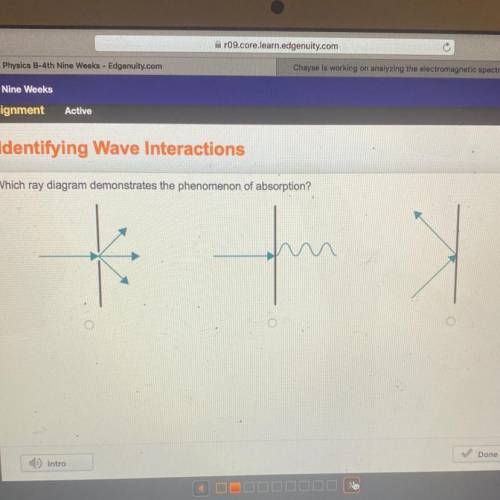Which ray diagram demonstrates the phenomenon of absorption?
...

Answers: 1


Another question on Physics

Physics, 22.06.2019 11:00
The charge on an electron is 1.60218 × 10−19 c and its mass is 9.10939 × 10−31 kg. how strong a magnetic field must be experienced by the electron if its path is a circle of radius 5.5 cm? answer in units of t.
Answers: 3

Physics, 22.06.2019 17:00
Two conductors, a and b, are each in the shape of a tetrahedron. but of different sizes. they are charged in the following manner: 1. tetrahedron a is charged from an electrostatic generator to charge q. 2. tetrahedron a is briefly touched to tetrahedron b. 3. steps 1 and 2 are repeated until the charge on tetrahedron b reaches a maximum value. if the charge on tetrahedron b was q/4 after the first time it touched tetrahedron a. what is the final charge qbmax on tetrahedron b?
Answers: 2

Physics, 23.06.2019 04:00
Preciso de ajuda na parte de termometria e tenho prova amanhã ajuda ae prf
Answers: 1

Physics, 23.06.2019 08:30
The center of a long frictionless rod is pivoted at the origin, and the rod is forced to rotate in a vertical plane with constant angular velocity \omega. write down the lagrangian for a bead of mass m threaded on the rod, using r as your generalized coordinate, where r, \phi are the polar coordinates of the bead. (notice that \phi is not an independent variable since it is fixed by the rotation of the rod tobe \phi = \omega * t) solve lagrange's equation for r(t). what happens if the bead is initially at rest at the origin? if it is released from any point ro > 0, show that r(t) eventually grows exponentially. explain your results in terms of the centrifugal force m* \omega ^2 *r.
Answers: 3
You know the right answer?
Questions












Geography, 10.01.2021 02:00

Mathematics, 10.01.2021 02:00

Physics, 10.01.2021 02:00





Mathematics, 10.01.2021 02:00




